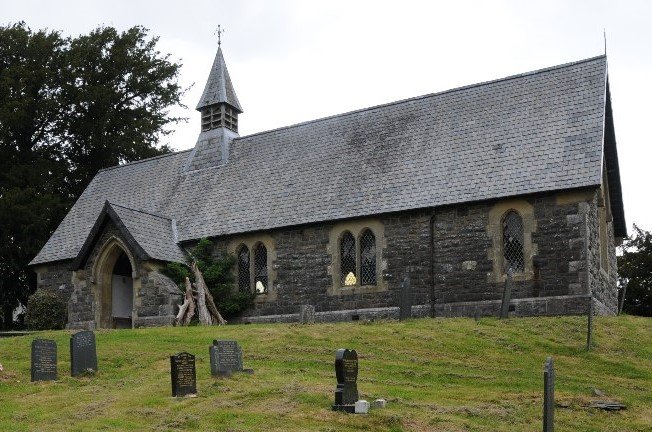Gwenfrewy: silent saints and headless maidens
“If I can’t have you I’ll make sure no-one will!”
All too many women hear this phrase and it can make the blood run cold. Perhaps Prince Caradoc said it to Gwenfrewy—better known today as St Winifride—when he cut off her head after she refused his “attempted familiarities”1. The prince had been hunting and, becoming thirsty, called at her parents’ home in what would become Holywell in Flintshire for a drink of water, where he found the young woman home alone.
Gwenfrewy made a run for it to her uncle Beuno’s nearby chapel, but was easily outpaced by the prince on horseback. One blow was enough to cut off her head, and where it fell the rock split open and a spring appeared. Gwenfrewy’s uncle heard the commotion and rushed out of the chapel, moments too late. He wasted no time in cursing the prince, so effectively, it’s said, that the young man melted away “like wax before the fire.”2 Beuno then popped his niece’s head back on her shoulders and she recovered, bearing only a scar to show for the attack. This happened on 22 June, some time in the early 7th century CE.
Stories like this are surprisingly common: written down in Medieval times but likely told orally from much earlier. St Beuno claimed to have raised at least six people from the dead, and there are a great many beheaded virgins in these old tales of saints. The 5th century virgin St Noyale, for example, had fled to Brittany by floating there on the leaf of a tree when her father insisted that she marry, only to have her head cut off by a local lord who also wished to wed her, but whom she refused. Noyale picked up her head and left Brittany for good, although three drops of blood fell to the ground from her head and a spring appeared where each drop fell. Her feast day is 6th July.
Both of these dates are close to the summer solstice, when in much of Europe midsummer was once celebrated by setting large wheels on fire and rolling them down hills into bodies of water just as the sun, having reached its zenith, now seemed to go downhill as the year turned. We still roll cheeses down hills in Gloucestershire in the early summer, which does seem reminiscent of this ancient celebration. Later, the Church deemed 23rd June as St John’s Eve, with one monk explaining that the bonfires allowed at this watery fire festival were intended to drive away the dragons that went about copulating and poisoning wells on this liminal night!


But Gwenfrewy’s resurrection was by no means the end of her story and after some time she moved to Gwytherin in Conwy, where she ended her days as Abbess of a small convent. Over the years the spring where her head had fallen became a famous healing shrine, and continues so to this day: St Winifride’s Well at Holywell has been in the hands of the Catholic Church for centuries, while long after Gwenfrewy’s death, in 1138, her relics were taken from the churchyard at Gwytherin and transferred to the Abbey at Shrewsbury, whence they disappeared during the Reformation except for, it’s said, part of one finger bone.
I visited Holywell in May, with some trepidation. A recovering Catholic and convent school girl, I’m never quite sure that a nun isn’t going to appear out of nowhere to sentence me to detention or an hour in the chapel to pray for my many sins!
It isn’t easy to visualise the original spring; the Gothic-style shrine is very elaborate, probably built in the late 15th century by the Abbot of nearby Basingwerk Abbey, possibly with help from Lady Margaret Beaufort, mother of Henry VII. Perhaps this was why the shrine escaped the worst of the Reformation begun by her grandson. But in the meantime it prospered and so, of course, did the Abbey—association with a site like this would hugely increase both the prosperity and prestige of a monastery, which perhaps explains why Shrewsbury Abbey was so keen to house Gwenfrewy’s remains. Pope Martin V granted Basingwerk Abbey permission to sell indulgences3 in 1427, and Mary Tudor later extended this right. And not only the abbey prospered, of course, there were plenty of traders along the pilgrimage route to sell you a bit of bone or other “saintly relic”. I saw no mention while at Holywell that in 1917 nearby mining works diverted the underground stream which had fed the well, so that it ran dry, meaning that the source of the water is actually no longer the original spring.4
While Gwenfrewy’s miraculous story and the cures that apparently followed certainly played their part in the fame of the shrine, also helping its renown are the red “ferruginous”5 veins underlying the stones and a red moss which used to grow there and which people thought reminiscent of the virgin saint’s spilled blood. The moss is also said to have smelt of violets and was gathered into garlands, known as St Winifride’s hair, to be taken to people unable to travel to Holywell themselves.
Now for a very different story, from an odd tale used as an introduction to Chrétien de Troye’s unfinished Conte du Graal, and known as The Elucidation, although in fact it adds layers of confusion rather than illumination. But the story goes that in Britain at this time, no traveller would suffer hunger or thirst because every well had an associated damsel, who would appear on request with the food and drink best liked by the traveller, served alongside a beautiful, golden cup. But then one day a wicked king called Amangon raped one of the damsels and took her golden cup for himself. His vassals followed his example and after this no damsels emerged from the wells and the land itself–so recently fertile–began to sicken, as did the king.
As Caitlín Matthews writes, the rape of the damsels meant that “the harmony that should exist between king and land is ruptured”.6 That is to say, his relationship with Sovereignty was destroyed. She also believes that the golden cup was certainly connected with Sovereignty, who always offers food and drink when she appears as Herself, so the cup may indeed be the Holy Grail. A generation or so after Amangon’s crime, King Arthur set up the Knights of the Round Table, who determined to recover the wells and protect the damsels. After the grail appeared at Arthur’s own court the wells flowed again, fields became green and forests verdant. But the damsels of the wells were gone forever.

Both stories tell of a fall from innocence. A beautiful damsel is threatened with rape and in some cases killed at the site of a well: an attack on the Goddess of the Land, on Sovereignty Herself. The damsels left the wells and never returned, but in the case of Gwenfrewy the rape and murder are “celebrated” by the appearance of the spring in a place previously known as “Sychnant” or “dry valley”. Did Gwenfrewy once represent the Goddess of the Land in these parts? In the Medieval stories she is given little or no sovereignty even over her own body, including long after her death, when her relics are passed around among patriarchal institutions. She is also silenced: we never hear a word from her. There is an unfinished play by the Jesuit poet Gerard Manley Hopkins7 in which we hear plenty from Caradoc the murderer and would-be rapist, who blames Gwenfrewy’s death on her beauty and suffers because he is unable to possess it, which probably tells us more about Hopkins than Caradoc. But we hear almost nothing from Gwenfrewy herself.
Despite the blasphemy against the Goddess of the Land and the silencing of Gwenfrewy we still have a beautiful and sacred pilgrimage site of our own to visit.8 Gwytherin is about eight miles from Llanrwst in Conwy, and the small church there is built on a circular mound dating back to at least the Bronze Age, with several ancient yews bearing witness, not to mention an alignment of four stones in the churchyard, which may have been moved to their present location after once being placed to mark Gwenfrewy’s grave on a nearby mound, desecrated long ago by greedy churchmen.
The church was closed in 2005 and may well have fallen into such disrepair that demolition would surely follow, but Alison Goulbourne, an artist and photographer, was so saddened by the neglect she saw on her first visit that she bought both church and burial mound to preserve the timelessness and beauty of the place.9 I visited the site twice, the second time to meet Alison, and we hope to discuss working together in the future to tell more of Gwenfrewy’s story and ensure that she is given a voice and her sovereignty is restored.
Geraldine Charles
20 June 2022
- Sabine Baring-Gould, The Lives of the British Saints Volume III, 1907
- Ibid.
- An indulgence granted full or partial remission from the punishment of sins.
- https://wellhopper.wales/2012/06/22/st-winefrides-well-holywell/ accessed 10 June 2022
- Iron or iron oxide colouration
- Caitlín Matthews, King Arthur and the Goddess of the Land, 2002, Inner Traditions
- Gerard Manley Hopkins, St Winefred’s Well
- The site is on the North Wales Pilgrims’ Way but the peace is not broken too much as the church is closed.
- https://www.thegwenfrewiproject.co.uk/ accessed 5 May 2022

